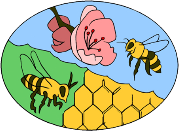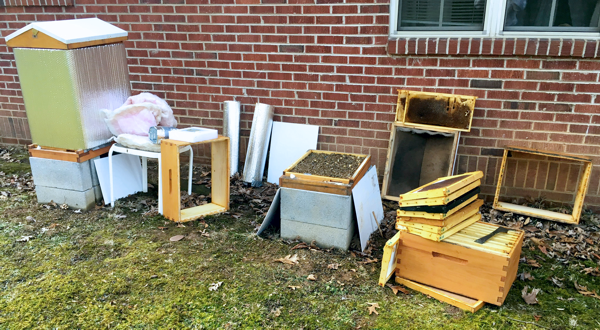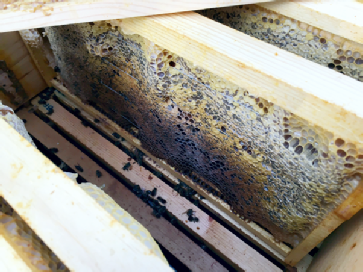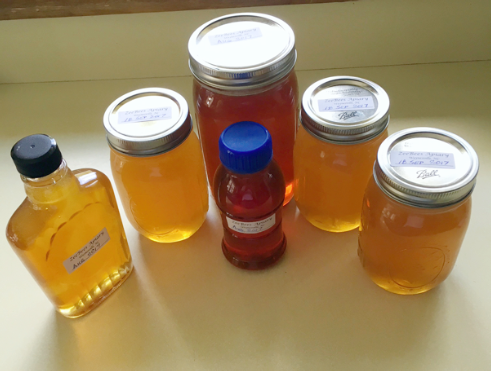




Every new beekeeper longs for the day when they can harvest that first jar of sweet nectar from their apiary and from what several long-time beekeepers have told me, I am blessed to get any harvest in the first year of beekeeping. All I can say is my bees are blessed and they have blessed me. From the information I have gathered it has been a good year for honey production. Compared to 2016, when the and was hot and dry, 2017 has turned into a bumper crop of honey production. Pollen and nectar counts are up, the weather has been great, and the bees have been busy.
Now, I understand the condition of my bees, what they need for their survival this coming winter, and I believe that the bees and I are in good position to weather the cold that is to follow. Each hive in the apiary has two brood boxes full of healthy bees, no major pests to speak of, and nine to ten frames of honey. The brood pattern is great, no “shotgun” patterns, still lots of eggs and larvae, and I could not be happier. With a standard “deep” frame of honey weighing about 9-10 pounds, the bees are in great shape so far and one hive even has 9 frames of honey (at various stages) in the medium super. Hive #1 did not not produce any honey in their medium super and in fact, they never even combed it out. However, hive #2 is producing at a rate much higher than I ever expected for a first-year hive.
These past twelve months of learning, studying, watching videos, asking questions, and becoming “certified” has shown me that beekeeping is a science, not a perfect science, but one that requires much participation by the beekeeper. My brother says, “There are beekeepers, and then, there are people who just keep bees.” Thus, as a “beekeeper” I have been rewarded for this hard work. I know the great “UP” that I am experiencing today can also turn into a depression “DOWN,” at some point in the future. However, I have learned that the science of beekeeping is a “dynamic” one, and ever changing. It requires beekeepers to stay abreast of their hives and to keep an ever watchful eye on them as the months progress and seasons change.
If you are a “new beekeeper,” take the time to study your bees, read all you can about the type of bees you have and know their PROS and CONS (see Races of Bees- pg 13-15 of Beekeeping in Tennessee). Always discern how good the information you get from others fits in with your style of Integrated Pest Management (IPM) and this includes what I say. Every beekeeper is different and you will learn your own method of managing your apiary, as I have. Maintain patience, monitor the hives, and increase your knowledge about your bees and you will reap the reward of that sweet “golden nectar.” I have and it is exhilarating!
All of the honey production came out of one hive and the bees entered the winter season on 4 November with approximately 70+ pounds of honey in two boxes.
Hive # 2 - Dead and Silent… 21 January 2018

First jar of golden nectar
22 July 2017 - 95 Days after the queen was released.

So, you really want to be a beekeeper? Well, it’s much like any other hobby, task, or business you might take up, because it definitely requires a “love” for beekeeping. If you love honey then, at some point during your association with your bees they will sting you, swarm away, or just suddenly die in massive numbers from cold, rain, wind, fire, and unfortunately poisoning. Even after getting sixteen stings during the 2017 season, I never complained about the bees because the ten pints of honey I harvested this first year makes everything sweeter.
Hive #1 was always the weaker of the two hives I started with on April 15, 2017. For 281 days these bees brought me joy and excitement and though one hive has now succumbed to weather and self-starvation I still receive joy when I look at hive #2 (Jan 23) and see bees flying around in the sunny 43 degree temperature. Hive #1 lived through 40 to 47 life cycles and they were still feeding brood when they died. During the initial analysis, I noticed several small clusters on about eight frames in the lower brood box.
Here are some other observations concerning Hive #1:
- There were always fewer bees in this hive than Hive #2 maintains,
- These bees only combed 18 of the 20-frames in the boxes,
- They never seemed to forage as much as Hive #2,
- They produced no honey in the one super that was in place for 11 weeks, and they combed half of one medium frame in the super,
- They entered the winter season (Nov 1, 2017) with approximately 45,000 bees in the hive and 50 to 60 pounds of capped honey,
- Their willingness to fly on cold sunny days was more evident than Hive #2; their last recorded outdoor flight was on 9 January 2018, when about 500 to 600 bees filled the air in front of their hive.
When I put some pieces of the puzzle together, here is what I found:
- No moisture in the hive body and a small amount of mold near the bottom of a couple frames in lower box,
- About eighty percent of the dead bees were lying on the screen bottom board and the entrance slot was completely covered,
- Ninety to ninety-five percent of the honey in the lower box was eaten,
- The several clusters of bees that were feeding brood died in place, with honey only an inch away and some bees head-first in many cells,
- Many frames in the lower box were completely void of any brood,
- Frames in the upper box still contain about twenty-five to thirty pounds of honey,
- Temperatures in January fluctuated from highs of 65 degrees F to lows of 1 degree and a wind-chill of -2 degrees,
- Winds for the past two weeks have averaged 7-9 mph, with gusts up to 40 mph and higher,
- The two snowfalls and cold winds kept the bees inside for up to six weeks and no chance of getting outside to exercise.
As a “beekeeper”, I tried my best to care for these little “stingers” through proper IPM and feedings of syrup and pollen. Both hives were bubble wrapped and shrouds placed around the bottom foundation of hive to protect against the winds and yet, they still died. Thus, I conclude the “cause of death” was based on three factors; 1) Weak queen genetics- they never excelled in great numbers, nor produced any comb to store honey, 2) Weak population numbers going into winter season, and 3) Weak clusters in the lower box near the partially-opened screen bottom board.
The difference between hive 1 and hive 2 is that hive 2 is still thriving because they are clustered in the upper box just under the inner cover opening, where I feed them syrup and pollen. They are farther away from the screened bottom board and started winter with over 20,000 more bees than hive 1.
In closing, three new Carniolan queens are ordered for an April 3 delivery and I am still focused on splitting the remaining hive and adding three new ones. I am not happy with losing about $700.00 worth of honeybees (about six packages worth), but I am not devastated as a beekeeper either because, I just read about a beekeeper in New Zealand who lost over forty hives, see : https://www.stuff.co.nz/environment/100810194/Accidental-poisoning-possible-cause-of-mass-bee-deaths-in-Murchison.
Bee Safe, Bee Productive, and Bee Thankful in all that we do as beekeepers.


Small Clusters Feeding Brood
21 Jan 2018 - 281 Days after the queen was released.
Hive #1 Upper Box
21 Jan 2018 - seven frames of honey still in box



First Batch of Sourwood Honey
17 Aug 2017
More golden nectar
18 September 2017 - Final production for the year
Workign like bees in a "new hive"












